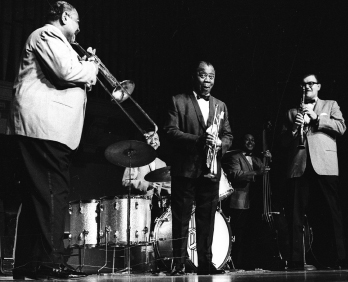The Rise of Pop Music
Printed Page 135
Though technological advancements made sound recording a mass medium and sparked the proliferation of pop music genres, this music had its earliest roots in something far less technical: sheet music. With mass production of sheet music in the nineteenth and early twentieth centuries, pop developed into a business fed by artists who set standards for the different genres—including jazz, rock, blues, and R&B.
Back in the late nineteenth century, a section of Broadway in Manhattan known as Tin Pan Alley began selling sheet music for piano and other instruments. (The name Tin Pan Alley referred to the way these quickly produced tunes supposedly sounded like cheap pans clanging together.) Songwriting along Tin Pan Alley helped transform pop music into big business. At the turn of the twentieth century, improvements in printing technology enabled song publishers to mass-produce sheet music for a growing middle class. Previously a novelty, popular music now became a major enterprise. With the emergence of the phonograph and recorded tunes, interest in and sales of sheet music soared. (Eventually, these sales would decline with the rise of radio in the 1920s, making audiences more into listeners in their music habits rather than active participants who were playing instruments from sheet music in their living rooms.)

As sheet music gained popularity and phonograph sales rose, jazz developed in New Orleans. An improvisational and mostly instrumental musical form, jazz absorbed and integrated a diverse array of musical styles, including African rhythms, blues, and gospel. Groups led by Louis Armstrong, Tommy Dorsey, and others counted among the most renowned of the “swing” jazz bands, whose rhythmic sound also dominated radio, recording, and dance halls.
The first pop vocalists of the twentieth century came out of vaudeville—stage performances featuring dancing, singing, comedy, and magic shows. By the 1930s, Rudy Vallée and Bing Crosby had established themselves as the first “crooners” singing pop standards. Bing Crosby also popularized Irving Berlin’s “White Christmas,” which became one of the most covered songs in recording history. (A song recorded or performed by another artist is known as cover music.) Meanwhile, the bluesy harmonies of a New Orleans vocal trio, the Boswell Sisters, influenced the Andrews Sisters, whose boogie-woogie style sold more than sixty million records in the late 1930s and 1940s. Helped by radio, pop vocalists like Frank Sinatra in the 1940s were among the first singers to win the hearts of a large national teen audience. Indeed, Sinatra’s early performances incited the kinds of audience riots that would later characterize rock-and-roll concerts.